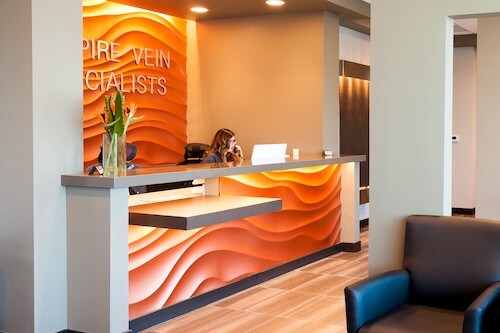While genetics play a big role in determining who gets varicose veins and who doesn’t, factors such as your occupation, lifestyle habits, even your diet also enter into the equation. Occupations that involve a lot of standing are known to increase risk and teaching falls squarely in that category.
Varicose veins are consistently at the top of the list of chronic health issues in teachers. A French study determined varicose veins to be the 7th most frequent such problem among teachers there[1]. Additionally, in a 2018 survey, 48% of teachers had been diagnosed with varicose veins but only 24% had a family history, indicating that something besides genetics, for example, diet and lifestyle factors, was involved in 50% of cases[2].
If you love teaching but don’t want the varicose veins that often go along with it, the following simple preventive steps can help reduce your risk.

1. Exercise
As a teacher, you can’t avoid long periods of standing but you can counteract it by exercising before or after work or during your lunch break. Exercises that work the legs, such as walking, jogging, and bicycling are best for varicose vein prevention. Choose activities you enjoy and are likely to stick with for the long term. Ten to 20 minutes a day is recommended for managing symptoms of existing varicose veins[3] or more with your doctor’s approval.
Keeping your circulation moving during work hours can be challenging. If you teach grade school, walking from one side of the white board to the other or up and down the aisles of a classroom are probably not going to generate the type of blood flow you need for healthy circulation. And if you’re a college professor who lectures from a desk or podium, you’re likely getting even less exercise. After years of teaching the calf pump can start to fail and studies have shown that to be the case in patients with venous insufficiency compared to those without[4].
A simple exercise can help. The idea is to activate the calf pump mechanism that is so essential for moving blood away from your legs. The calf pump exercise simply involves pointing and flexing your ankle and toes repeatedly while in a seated position. It doesn’t require any special equipment but you can hold a resistance band placed around the bottom of your foot to increase the intensity[4]. Additionally, toe raises – rising up onto your toes in a standing position is a great calf pump exercise that can be done right in the classroom.
2. Maintain a Healthy Weight
To prevent or manage varicose veins it’s important to stay in control of those factors that are under your control and managing your weight is one of those factors. Though the precise reasons aren’t known, some experts suggest that extra abdominal weight increases pressure in the abdomen, which impedes the return blood flow and raises pressure in the veins. This is true for everyone who is overweight but is particularly problematic for teachers, who already deal with occupational risk.
Losing weight is well worth the effort where varicose vein prevention is concerned. In one study, nearly all participants showed improved venous blood flow following weight loss[5]. Achieving and maintaining your ideal weight can also keep your joints healthy and pain-free so you can get the exercise you need to keep your venous circulation in top shape.

3. Go Ahead, Put Your Feet Up!
We probably don’t have to tell you how good it feels to prop your feet up on your desk or a chair in between classes or at breaks during a long day of teaching. If you have been reluctant to do so because it’s frowned upon at your school or you feel like it’s unprofessional or overly casual, you can now do so with confidence that you are responsibly putting your health first.
Elevating the lower legs is one of the most important things you can do to prevent or manage varicose veins. Doctors recommend it because it promotes return blood blow and reduces pressure in the veins, which stops the cycle of events that leads to varicose veins and slows the progression of existing ones, and alleviates symptoms like swelling, aching/throbbing, and limb heaviness and fatigue[5].
4. Choose Your Footwear Wisely
Your choice of footwear can help or hinder your venous circulation. Heels might look stylish but they simply aren’t worth it when, at the end of the day you pay the price in swollen, achy feet and legs. Instead, choose flats, which can be elegant while remaining comfortable and professional, or athletic shoes.
There are also ways to make your footwear work for you in terms of preventing varicose veins. For example, orthotic inserts can help make your foot and ankle work more efficiently, which translates to improved blood flow[6]. Orthotics have even been found to improve venous circulation more than wearing firm shoes, doing ankle mobilization exercises, or being barefoot[6,7]. Additionally, unstable shoes such as rocker sole shoes, which have a thicker sole and a rounded heel compared to a normal shoe, or negative heel shoes in which the heel is lower than the rest of the foot work the muscles of your feet and legs differently from regular shoes, providing an extra boost of calf pump activity with each step[6].

5. Wear Compression Stockings
Compression stockings are a must for anyone with existing varicose veins who wants to keep them from progressing. They do a great job at preventing swelling and considerably reduce leg discomfort that sets in during a full day of being on your feet. Varicose vein patients who use compression stockings report significant improvements in their quality of life, including decreased swelling, aching, heaviness, pain, leg cramps, and restless legs [8]. Compression stockings also help prevent sores known as venous leg ulcers, which are challenging and slow to heal[8].
6. Get VenaSeal Treatment
If you’re a teacher and have varicose veins, there are great minimally invasive procedures that can resolve the problem in its early stages and prevent you from enduring years of pain and suffering. One option is VenaSeal™, which uses a medical grade adhesive to seal off varicose veins. VenaSeal™ is performed in a clinic setting and takes less than an hour. VenaSeal ranked highest in effectiveness, lowest in post-procedural pain, and lowest in complications when compared to surgery and other treatment options, in one study[9]. After VenaSeal™ treatment you can walk out of the clinic and resume your normal activities with no downtime needed for healing.

Empire Vein & Vascular Specialists is the top provider of VenaSeal™, the leading outpatient varicose vein treatment, in the USA.
To learn about which vein treatment is right for you we invite you to schedule a free consultation at Desert Vein and Vascular Institute. All of our physicians are board-certified vascular surgeons who specialize in helping people like you.
To schedule a free consultation, please call 1-800-827-4267 (1-800-827-4267) today.
References
- Do teachers have more health problems? Results from a French cross-sectional survey. BMC Public Health, 2006. 6: p. 101
https://www.ncbi.nlm.nih.gov/pubmed/16630336 - Long and permanent standing of the teachers is one of the factors for the appearance of varicose veins on the lower limbs. Knowledge in Practice, 2018
https://ikm.mk/ojs/index.php/KIJ/article/view/219/719 - Prevention of Varicose Veins. International Journal of Advances in Nursing Management
https://www.researchgate.net/profile/Malar-Kodi-3/publication/294764354_Prevention_of_Varicose_Veins/links/56c3e70108aeeaf199f9010d/Prevention-of-Varicose-Veins.pdf - Improving the calf pump using home-based exercises for patients with chronic venous disease. 2008; Judy Davies, R.B., Ina Farrelly, Melanie Wakelin. https://www.woundsinternational.com/uploads/resources/content_147.pdf
- Pathogenesis of varicose veins and implications for clinical management. Vascular, 2007. 15(5): p. 242-9
https://www.ncbi.nlm.nih.gov/pubmed/17976322 - The effects of shoe type on lower limb venous status during gait or exercise: A systematic review. PLoS One, 2020. 15(11): p. e0239787
https://www.ncbi.nlm.nih.gov/pubmed/33237916 - The effect of footwear on venous pressure at the ankle. J Cardiovasc Surg (Torino), 1977. 18(2): p. 117-21
https://www.ncbi.nlm.nih.gov/pubmed/853053 - Indications for medical compression stockings in venous and lymphatic disorders: An evidence-based consensus statement. Phlebology, 2018. 33(3): p. 163-184
https://www.ncbi.nlm.nih.gov/pubmed/28549402 - Network meta-analysis to compare VenaSeal with other superficial venous therapies for chronic venous insufficiency. J Vasc Surg Venous Lymphat Disord, 2020. 8(3): p. 472-481 e3
https://www.ncbi.nlm.nih.gov/pubmed/32063522